Bitcoin’s Sugar-High Weekend Ends in a Trade-War Hangover
July 7, 2025
Trump screwed the pooch, again. After Bitcoin spent Sunday strutting toward $109,700, and potentially new all-time highs, Trump’s tariff letters spoiled the party as the U.S. workweek began.
By Monday afternoon, the flagship crypto had sunk to about $107,700, wiping out its entire weekend gain and posting a 0.8 percent 24-hour loss. Ethereum mirrored the slide at –0.6 percent, while mid-caps Solana, Dogecoin and Sui gave back 1–2 percent. The lone rebel was XRP, up more than 2 percent, powered by its own legal-saga tailwinds. It’s a feeling of Déjà vu for Bitcoin holders, every time Bitcoin gets some momentum behind it, Trump starts another round of tariff terrors and momentum slides away.
Bitcoin slipped as Trump’s tariff terrors continue to spook markets, Source: BNC Bitcoin Liquid Index
Tariffs From 0-to-25 in 280 Characters
The spark was another Twitter-but-for-presidents blast: Donald Trump’s Truth Social posts revealed 25 percent levies on imports from Japan and South Korea starting Aug. 1. Letters to Kazakhstan and Malaysia carried the same 25 percent sting; South Africa drew 30 percent; Myanmar and Laos, 40 percent. The White House simultaneously moved its self-imposed trade-deal deadline from July 9 to Aug. 1, buying time for frenetic negotiations—and for markets to sweat.
In a separate volley, Trump threatened an extra 10 percent tariff on any country that “aligns with the anti-American policies of the BRICS.” BRICS—now an 11-nation bloc spanning from Brazil to Saudi Arabia—was wrapping day one of a Rio summit when the threat landed.
Press Secretary Karoline Leavitt hinted more letters are “in the mail,” stoking fears the tariff net could soon cover most of Asia and Africa. Investors translated that into higher input costs and stickier inflation, dumping risk assets accordingly.
Macro Dominoes: Stocks, Bonds, and the Fear Trade
Wall Street heard the message. The S&P 500 and Nasdaq each fell roughly 1 percent, while the 10-year Treasury yield poked above 4.35 percent—its highest level since early May—as bond traders braced for another inflation pulse.
That environment is kryptonite for speculative bets: higher yields make holding dollars more attractive and tighten global liquidity. Crypto, still a teenager in macro-cycle years, duly flinched.
A Tariff on Your Friends?
Targeting Japan and South Korea—America’s long-time security allies—sent an especially jarring signal. Tokyo and Seoul supply everything from EV batteries to semiconductor etchers. Slapping 25 percent on that pipeline is the policy equivalent of eating your seed corn. The move also complicates U.S. efforts to build a “Chip-Four” alliance (U.S., Japan, South Korea, Taiwan) to blunt China’s semiconductor rise. If South Korean giants Samsung and SK Hynix decide Washington is a fickle partner, expect more fabs on Chinese soil—precisely what the Biden-era CHIPS Act tried to prevent.
Trump’s letter to Japan, threatening 25% tariffs, a classic how to win friends and influence people negotiation tactic, Source: X
Contrarian take: the tariffs may accelerate de-dollarization. Nations feeling the tariff heat could settle bilateral trade in yuan, rupees, or—sacrilege—USDT. Every basis-point shift away from the dollar nudges Bitcoin toward reserve-asset respectability, even if the first-day reaction is a panic sell-off. In other words, Monday’s drop might be the dress rehearsal for a long-term bullish narrative. So yes, now could still be a good time to buy Bitcoin and crypto.
Crypto Micro-Moves: Why XRP Outshone the Pack
While Bitcoin and ether slipped, XRP’s 2 percent pop underscored that protocol-specific catalysts can override macro gloom. In Ripple news, rumors swirl that Ripple’s long-running SEC case may settle this quarter, potentially unlocking U.S. exchange relistings. If that happens, the token’s relative insulation from tariff-driven dollar moves could make it a quirky hedge within the crypto basket. The XRP price could be set to out perform.
Looking Down the Barrel of August 1
The new drop-dead date matters. If no trade pacts materialize, $150 billion-plus in Asian exports will be taxed overnight. Multinationals racing to front-load shipments could jam West Coast ports next month, echoing the 2020 supply-chain crunch. That’s inflationary for Main Street and liquidity-draining for markets—a double whammy Bitcoin typically hates in the short run.
Traders now eye support around $105 k. A decisive break could open the slide toward the psychological $100 k handle, last visited in early May. Conversely, any hint of tariff detente—or a softer-than-expected July CPI print on July 12—could hand Bitcoin the narrative ammo to reclaim $110,000 and push on to new all time highs. Our Bitcoin price prediction remains new all-time highs sooner, not later.
The Bigger Picture: Trade Wars, Currency Wars, Value Wars
2018’s tariff skirmish was about steel and soybeans. 2025’s version feels existential: align with Washington or face the bill. That binary proposition pushes the U.S. vs BRICS fault line into everyday commerce, from phones to shoes. History says tariff wars rarely end neatly—they morph into currency wars, and Bitcoin’s birth in 2009 was itself a reaction to fiat chaos.
In the near term, Bitcoin remains hostage to macro headlines. But if the tariff drumbeat hastens a multipolar trading system, the blockchain native that settles anywhere, anytime, looks less like a speculative toy and more like an escape hatch. Monday’s dip could be Mr. Market temporarily mispricing that insurance.
Search
RECENT PRESS RELEASES
Related Post




